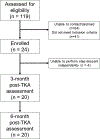Step descent strategy is altered bilaterally despite unilateral muscle strength impairment after total knee arthroplasty
- PMID: 31201440
- PMCID: PMC6911032
- DOI: 10.1007/s00167-019-05554-8
Step descent strategy is altered bilaterally despite unilateral muscle strength impairment after total knee arthroplasty
Abstract
Purpose: Muscle weakness and difficulty descending stairs are common after unilateral total knee arthroplasty (TKA), but the relationship between each is unclear. The purpose of this study was to compare lower extremity muscle strength, lower extremity support moments during step descent, and assess relationships between each.
Methods: The study included 40 subjects (20 post-TKA, 20 control). Knee extensor, hip abductor, and hip external rotator strength were measured and biomechanical analyses of step descent performed. Patients with TKA were assessed 3 and 6 months post-surgery.
Results: At 3 and 6 months post-TKA, operated limb hip external rotator and knee extensor strength were impaired compared to the non-operated limb (p < 0.01); however, no between-limb differences were observed during step descent. Compared to the control group, hip external rotator and knee extensor strength, total lower extremity support moment, and knee support moment during step descent were impaired post-TKA (p < 0.05). At 6 months post-TKA, knee extensor and hip external rotator strength correlated with total support moment during step descent (rs = 0.40, 0.41, p < 0.02). Hip abductor and external rotator strength negatively correlated with knee support moment during step descent (rs = - 0.35, - 0.39, p < 0.03).
Conclusions: Persistent operative limb knee extensor and hip external rotator muscle weakness are noted following unilateral TKA. Despite unilateral weakness, bilateral alterations in step descent strategy occur following TKA. Patients with TKA utilize hip musculature to reduce knee muscle demand during step descent, possibly contributing to limitations in long-term step descent performance.
Keywords: Hip strength; Quadriceps strength; Stair descent; Total knee arthroplasty; Total support moment.
Figures
Similar articles
-
Relationship between biomechanical asymmetries during a step up and over task and stair climbing after total knee arthroplasty.Clin Biomech (Bristol). 2015 Jan;30(1):78-85. doi: 10.1016/j.clinbiomech.2014.11.001. Epub 2014 Nov 8. Clin Biomech (Bristol). 2015. PMID: 25467765 Free PMC article.
-
Does the addition of hip strengthening exercises improve outcomes following total knee arthroplasty? A study protocol for a randomized trial.BMC Musculoskelet Disord. 2016 Jun 13;17:259. doi: 10.1186/s12891-016-1104-x. BMC Musculoskelet Disord. 2016. PMID: 27295978 Free PMC article. Clinical Trial.
-
Quadriceps strength asymmetry predicts loading asymmetry during sit-to-stand task in patients with unilateral total knee arthroplasty.Knee Surg Sports Traumatol Arthrosc. 2016 Aug;24(8):2587-94. doi: 10.1007/s00167-015-3827-x. Epub 2015 Oct 8. Knee Surg Sports Traumatol Arthrosc. 2016. PMID: 26450826
-
The relationship between prescribed pre-operative knee-extensor exercise dosage and effect on knee-extensor strength prior to and following total knee arthroplasty: a systematic review and meta-regression analysis of randomized controlled trials.Osteoarthritis Cartilage. 2020 Nov;28(11):1412-1426. doi: 10.1016/j.joca.2020.08.011. Epub 2020 Sep 2. Osteoarthritis Cartilage. 2020. PMID: 32890744
-
Hip Abductor Muscle Strength in Patients After Total Knee Arthroplasty: A Systematic Review and Meta-Analysis.J Arthroplasty. 2025 Jul;40(7):1899-1909. doi: 10.1016/j.arth.2024.11.057. Epub 2024 Nov 30. J Arthroplasty. 2025. PMID: 39622427
References
-
- Benedetti MG, Merlo A, Leardini A (2013) Inter-laboratory consistency of gait analysis measurements. Gait Posture 38:934–939 - PubMed
-
- Bjerke J, Ohberg F, Nilsson KG, Foss OA, Stensdotter AK (2014) Peak knee flexion angles during stair descent in TKA patients. J Arthroplasty 29:707–711 - PubMed
-
- Christensen JC, LaStayo PC, Mizner RL, Marcus RL, Pelt CE, Stoddard GJ, et al. (2017) Joint mechanical asymmetries during low- and high-demand mobility tasks: Comparison between total knee arthroplasty and healthy-matched peers. Gait Posture 60:104–110 - PubMed
MeSH terms
Grants and funding
LinkOut - more resources
Full Text Sources
Medical


